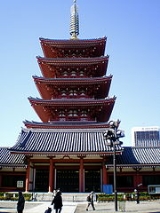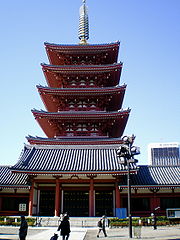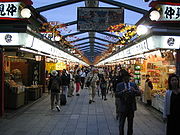
Senso-ji
Encyclopedia
is an ancient Buddhist temple located in Asakusa
, Taitō, Tokyo
. It is Tokyo's oldest temple, and one of its most significant. Formerly associated with the Tendai
sect
, it became independent after World War II
. Adjacent to the temple is a Shinto shrine, the Asakusa Shrine
.
Kannon, also known as Guan Yin or the Goddess of Mercy. According to legend, a statue of the Kannon was found in the Sumida River
in 628 by two fishermen, the brothers Hinokuma Hamanari and Hinokuma Takenari. The chief of their village, Hajino Nakamoto, recognized the sanctity of the statue and enshrined it by remodeling his own house into a small temple in Asakusa
, so that the villagers could worship the Kannon.
The first temple was built on the site in 645, which makes it the oldest temple in Tokyo. In the early years of the Tokugawa shogunate
, Tokugawa Ieyasu
designated Sensō-ji as tutelary
temple of the Tokugawa clan
.
The Nishinomiya Inari Shrine
is located within the precincts of Sensō-ji; and a torii
identifies the entry into the hallowed ground of a Shinto shrine. A bronze plaque on the gateway structure lists those who contributed to the construction of the torii, which was erected in 1727 (Kyōhō
12, 11th month).
During World War II, the temple was bombed and for the most part destroyed. It was rebuilt later and is a symbol of rebirth and peace to the Japanese people. In the courtyard there is a tree that was hit by a bomb in the air raids, it had regrown in the husk of the old tree and is a similar symbol to the temple itself.
(Shinto festival), Sanja Matsuri
. This takes place over 3–4 days in late spring, and sees the surrounding streets closed to traffic from dawn until late evening.

 Dominating the entrance to the temple is the Kaminarimon
Dominating the entrance to the temple is the Kaminarimon
or "Thunder Gate". This imposing Buddhist structure features a massive paper lantern dramatically painted in vivid red-and-black tones to suggest thunderclouds and lightning. Beyond the Kaminarimon is Nakamise-dori with its shops, followed by the Hōzōmon
or "Treasure House Gate" which provides the entrance to the inner complex. Within the precincts stand a stately five-story pagoda
and the main hall, devoted to Kannon Bosatsu
.
Many tourists, both Japanese
and from abroad, visit Sensō-ji every year. Catering to the visiting crowds, the surrounding area has many traditional shops and eating places that feature traditional dishes (hand-made noodles, sushi, tempura, etc.). Nakamise-Dori, the street leading from the Thunder Gate to the temple itself, is lined with small shops selling souvenirs ranging from fans, ukiyo-e
(woodblock prints
), kimono
and other robes, Buddhist scroll
s, traditional sweets, to Godzilla
toys, t-shirts, and cell-phone
straps. These shops themselves are part of a living tradition of selling to pilgrim
s who walked to Sensō-ji.
Within the temple itself, and also at many places on its approach, there are omikuji
stalls. For a suggested donation of 100 yen, visitors may consult the oracle and divine answers to their questions. Querent
s shake labelled sticks from enclosed metal containers and read the corresponding answers they retrieve from one of 100 possible drawers.
Within the temple is a quiet contemplative garden
kept in the distinctive Japanese style.
 The is a street on the approach to the temple. It is said to have come about in the early 18th century, when neighbors of Sensō-ji were granted permission to set up shops on the approach to the temple. However, in May 1885 the government of Tokyo ordered all shop owners to leave. In December of that same year the area was reconstructed in Western-style brick. During the 1923 Great Kantō earthquake
The is a street on the approach to the temple. It is said to have come about in the early 18th century, when neighbors of Sensō-ji were granted permission to set up shops on the approach to the temple. However, in May 1885 the government of Tokyo ordered all shop owners to leave. In December of that same year the area was reconstructed in Western-style brick. During the 1923 Great Kantō earthquake
many of the shops were destroyed, then rebuilt in 1925 using concrete, only to be destroyed again during the bombings of World War II.
The length of the street is approximately 250 meters and contains around 89 shops.
Asakusa
is a district in Taitō, Tokyo, Japan, most famous for the Sensō-ji, a Buddhist temple dedicated to the bodhisattva Kannon. There are several other temples in Asakusa, as well as various festivals.- History :...
, Taitō, Tokyo
Taito, Tokyo
is one of the 23 special wards of Tokyo, Japan. In English, it calls itself Taito City.As of April 1, 2011, the ward has an estimated population of 168,909, with 94,908 households, and a population density of 16,745.86 persons per km². The total area is 10.08 km².-History:The ward was founded...
. It is Tokyo's oldest temple, and one of its most significant. Formerly associated with the Tendai
Tendai
is a Japanese school of Mahayana Buddhism, a descendant of the Chinese Tiantai or Lotus Sutra school.Chappell frames the relevance of Tendai for a universal Buddhism:- History :...
sect
Sect
A sect is a group with distinctive religious, political or philosophical beliefs. Although in past it was mostly used to refer to religious groups, it has since expanded and in modern culture can refer to any organization that breaks away from a larger one to follow a different set of rules and...
, it became independent after World War II
World War II
World War II, or the Second World War , was a global conflict lasting from 1939 to 1945, involving most of the world's nations—including all of the great powers—eventually forming two opposing military alliances: the Allies and the Axis...
. Adjacent to the temple is a Shinto shrine, the Asakusa Shrine
Asakusa Shrine
, also known as Sanja-sama , is one of the most famous Shinto shrines in Tokyo, Japan. Located in Asakusa, the shrine honors the three men who founded the Sensō-ji. Asakusa Shrine is part of a larger grouping of sacred buildings in the area...
.
History
The temple is dedicated to the bodhisattvaBodhisattva
In Buddhism, a bodhisattva is either an enlightened existence or an enlightenment-being or, given the variant Sanskrit spelling satva rather than sattva, "heroic-minded one for enlightenment ." The Pali term has sometimes been translated as "wisdom-being," although in modern publications, and...
Kannon, also known as Guan Yin or the Goddess of Mercy. According to legend, a statue of the Kannon was found in the Sumida River
Sumida River
The is a river which flows through Tokyo, Japan. It branches from the Arakawa River at Iwabuchi and flows into Tokyo Bay. Its tributaries include the Kanda and Shakujii rivers....
in 628 by two fishermen, the brothers Hinokuma Hamanari and Hinokuma Takenari. The chief of their village, Hajino Nakamoto, recognized the sanctity of the statue and enshrined it by remodeling his own house into a small temple in Asakusa
Asakusa
is a district in Taitō, Tokyo, Japan, most famous for the Sensō-ji, a Buddhist temple dedicated to the bodhisattva Kannon. There are several other temples in Asakusa, as well as various festivals.- History :...
, so that the villagers could worship the Kannon.
The first temple was built on the site in 645, which makes it the oldest temple in Tokyo. In the early years of the Tokugawa shogunate
Tokugawa shogunate
The Tokugawa shogunate, also known as the and the , was a feudal regime of Japan established by Tokugawa Ieyasu and ruled by the shoguns of the Tokugawa family. This period is known as the Edo period and gets its name from the capital city, Edo, which is now called Tokyo, after the name was...
, Tokugawa Ieyasu
Tokugawa Ieyasu
was the founder and first shogun of the Tokugawa shogunate of Japan , which ruled from the Battle of Sekigahara in 1600 until the Meiji Restoration in 1868. Ieyasu seized power in 1600, received appointment as shogun in 1603, abdicated from office in 1605, but...
designated Sensō-ji as tutelary
Tutelary
A tutelary is a deity or spirit who is a guardian, patron or protector of a particular place, geographic feature, person, lineage, nation, culture or occupation. Both tutelary and tutelar can be used as either a noun or an adjective...
temple of the Tokugawa clan
Tokugawa clan
The was a powerful daimyo family of Japan. They nominally descended from Emperor Seiwa and were a branch of the Minamoto clan by the Nitta clan. However, the early history of this clan remains a mystery.-History:...
.
The Nishinomiya Inari Shrine
Inari Shrine
is a shinto shrine to worship the god Inari. There are many Inari shrines in Japan. The deity is worshiped also in some Buddhist temples.-Shrines and offerings:Inari is a popular deity with shrines and Buddhist temples located throughout most of Japan...
is located within the precincts of Sensō-ji; and a torii
Torii
A is a traditional Japanese gate most commonly found at the entrance of or within a Shinto shrine, where it symbolically marks the transition from the profane to the sacred...
identifies the entry into the hallowed ground of a Shinto shrine. A bronze plaque on the gateway structure lists those who contributed to the construction of the torii, which was erected in 1727 (Kyōhō
Kyoho
was a after Shōtoku and before Gembun. This period spanned the years from July 1716 through April 1736. The reigning emperors were and .-Change of era:...
12, 11th month).
During World War II, the temple was bombed and for the most part destroyed. It was rebuilt later and is a symbol of rebirth and peace to the Japanese people. In the courtyard there is a tree that was hit by a bomb in the air raids, it had regrown in the husk of the old tree and is a similar symbol to the temple itself.
Temple grounds
Sensō-ji is the focus of Tokyo's largest and most popular matsuriJapanese festivals
Japanese festivals are traditional festive occasions. Some festivals have their roots in Chinese festivals but have undergone dramatic changes as they mixed with local customs....
(Shinto festival), Sanja Matsuri
Sanja Matsuri
, or Sanja Festival, is one of the three great Shinto festivals in Tokyo, along with the Kanda Matsuri and Sannō Matsuri. It is considered one of the wildest and largest. The festival is held in honor of Hinokuma Hamanari, Hinokuma Takenari and Hajino Nakatomo, the three men who established and...
. This takes place over 3–4 days in late spring, and sees the surrounding streets closed to traffic from dawn until late evening.


Kaminarimon
The is the outer of two large entrance gates that ultimately leads to the Sensō-ji in Asakusa, Tokyo, Japan. The gate, with its lantern and statues, is popular with tourists. It stands 11.7 m tall, 11.4 m wide and covers and area of 69.3 m2.- History :The Kaminarimon was first...
or "Thunder Gate". This imposing Buddhist structure features a massive paper lantern dramatically painted in vivid red-and-black tones to suggest thunderclouds and lightning. Beyond the Kaminarimon is Nakamise-dori with its shops, followed by the Hōzōmon
Hozomon
The is the inner of two large entrance gates that ultimately leads to the Sensō-ji in Asakusa, Tokyo. A two-story gate , the Hōzōmon's second story houses many of the Sensō-ji's treasures. The first story houses two statues, three lanterns and two large sandals...
or "Treasure House Gate" which provides the entrance to the inner complex. Within the precincts stand a stately five-story pagoda
Pagoda
A pagoda is the general term in the English language for a tiered tower with multiple eaves common in Nepal, India, China, Japan, Korea, Vietnam and other parts of Asia. Some pagodas are used as Taoist houses of worship. Most pagodas were built to have a religious function, most commonly Buddhist,...
and the main hall, devoted to Kannon Bosatsu
Bodhisattva
In Buddhism, a bodhisattva is either an enlightened existence or an enlightenment-being or, given the variant Sanskrit spelling satva rather than sattva, "heroic-minded one for enlightenment ." The Pali term has sometimes been translated as "wisdom-being," although in modern publications, and...
.
Many tourists, both Japanese
Japanese people
The are an ethnic group originating in the Japanese archipelago and are the predominant ethnic group of Japan. Worldwide, approximately 130 million people are of Japanese descent; of these, approximately 127 million are residents of Japan. People of Japanese ancestry who live in other countries...
and from abroad, visit Sensō-ji every year. Catering to the visiting crowds, the surrounding area has many traditional shops and eating places that feature traditional dishes (hand-made noodles, sushi, tempura, etc.). Nakamise-Dori, the street leading from the Thunder Gate to the temple itself, is lined with small shops selling souvenirs ranging from fans, ukiyo-e
Ukiyo-e
' is a genre of Japanese woodblock prints and paintings produced between the 17th and the 20th centuries, featuring motifs of landscapes, tales from history, the theatre, and pleasure quarters...
(woodblock prints
Woodblock printing
Woodblock printing is a technique for printing text, images or patterns used widely throughout East Asia and originating in China in antiquity as a method of printing on textiles and later paper....
), kimono
Kimono
The is a Japanese traditional garment worn by men, women and children. The word "kimono", which literally means a "thing to wear" , has come to denote these full-length robes...
and other robes, Buddhist scroll
Scroll
A scroll is a roll of parchment, papyrus, or paper, which has been drawn or written upon.Scroll may also refer to:*Scroll , the decoratively curved end of the pegbox of string instruments such as violins...
s, traditional sweets, to Godzilla
Godzilla
is a daikaijū, a Japanese movie monster, first appearing in Ishirō Honda's 1954 film Godzilla. Since then, Godzilla has gone on to become a worldwide pop culture icon starring in 28 films produced by Toho Co., Ltd. The monster has appeared in numerous other media incarnations including video games,...
toys, t-shirts, and cell-phone
Mobile phone
A mobile phone is a device which can make and receive telephone calls over a radio link whilst moving around a wide geographic area. It does so by connecting to a cellular network provided by a mobile network operator...
straps. These shops themselves are part of a living tradition of selling to pilgrim
Pilgrim
A pilgrim is a traveler who is on a journey to a holy place. Typically, this is a physical journeying to some place of special significance to the adherent of a particular religious belief system...
s who walked to Sensō-ji.
Within the temple itself, and also at many places on its approach, there are omikuji
Omikuji
Omikuji are random fortunes written on strips of paper at Shinto shrines and Buddhist temples in Japan. Literally "sacred lot", these are usually received by making a small offering and randomly choosing one from a box, hoping for the resulting fortune to be good...
stalls. For a suggested donation of 100 yen, visitors may consult the oracle and divine answers to their questions. Querent
Querent
Querent as "one who seeks" is derived, according to the Oxford English Dictionary, from the Latin quærēns "seeker," the present participle of quærere "to seek, gain, ask."...
s shake labelled sticks from enclosed metal containers and read the corresponding answers they retrieve from one of 100 possible drawers.
Within the temple is a quiet contemplative garden
Japanese garden
, that is, gardens in traditional Japanese style, can be found at private homes, in neighborhood or city parks, and at historical landmarks such as Buddhist temples, Shinto shrines and old castles....
kept in the distinctive Japanese style.
Nakamise-dōri

1923 Great Kanto earthquake
The struck the Kantō plain on the Japanese main island of Honshū at 11:58:44 am JST on September 1, 1923. Varied accounts hold that the duration of the earthquake was between 4 and 10 minutes...
many of the shops were destroyed, then rebuilt in 1925 using concrete, only to be destroyed again during the bombings of World War II.
The length of the street is approximately 250 meters and contains around 89 shops.
See also
- For an explanation of terms concerning Japanese Buddhism, Japanese Buddhist art, and Japanese Buddhist temple architecture, see the Glossary of Japanese BuddhismGlossary of Japanese BuddhismThis is the glossary of Japanese Buddhism, including major terms the casual reader might find useful in understanding articles on the subject. Words followed by an asterisk are illustrated by an image in one of the photo galleries...
. - List of National Treasures of Japan (writings)
Gallery
- List of Buddhist temples
- Buddhist temples in JapanBuddhist temples in JapanAlong with Shinto shrines, Buddhist temples are the most numerous, famous, and important religious buildings in Japan.The term "Shinto shrine" is used in opposition to "Buddhist temple" to mirror in English the distinction made in Japanese between Shinto and Buddhist religious structures. In...
External links
- Images: Shopping along Nakamise.
- Images: Senso-ji
- Senso-ji Main Hall (Japanese)

